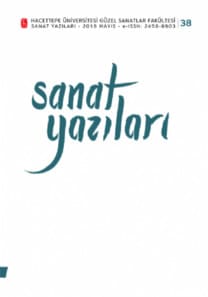ARMAN T. MANOOKİAN: KAYIP CENNETİN İMGESİ
Türkiye'de modern sanat tarihini araştıranların büyük bir çoğunluğunun gözden kaçırdığı önemli bir eksiklik, yüreklerinde büyük acılarla bu topraklardan kaçmaya mecbur bırakılan sanatçıların hikâyeleri ve yapıtlarıdır. Onların, kökeni bu topraklarda bulunan eserleri, şeytanın ayak basmadığı cennetin melodisine özlemle doludur. Birçoğu, doğdukları vatandan uzak, bir kurtuluş beklentisinde, dönülmez yola erkenden gitmeyi seçti. Edebiyatta Sivas doğumlu Varoujan, müzikte Kütahyalı Komitas ve resimde Vanlı Manoug Adoyan (Archile Gorky) günümüzde Anadolu sanat tarihi içinde az çok tanınmaktadır. Bu yazı, Prof. John Seed'in tarihi verileri esas alınarak, İstanbullu Arman Tateos Manookian'ın eserleri ve onun sanatsal düşünceleri doğrultusunda hazırlanmıştır. Makalede, Manookian'ın eserlerindeki kaybolmuş cennet imgesi ve bu imgenin mitolojik kökenleri incelenmiştir. Ayrıca, sanatçının kullandığı plastik dilin, modern sanat akımlarıyla olan ilişkisi değerlendirilmiştir. Bu bağlamda bu çalışma, Paul Gauguin'in Tahiti'deki sanatsal tecrübesinden yararlanmıştır
ARMAN T. MANOOKIAN: THE IMAGE OF THE LOST PARADISE
The important gap which close to all of Turkey’s modern art history researchers have overlooked is the life stories and artworks of the artists who have had to escape from these lands with great sorrow in their hearts. Theirs artworks which are rooted in this land are full of yearning for the melody of the paradise which the devil hasn’t set foot on it. Most of them prematurely chose the no return way, expecting for a salvation. Varoujan from Sebastia in literature, musician Komitas from Cotyaem and Manoug Adoyan (Archile Gorky) from Van more or less are known in Anatolian art history todeys. This article that is based on historical datas from Prof. John Seed’s researches, is prepared about Arman Tateos Manookian’s artistic concepts and artworks who was born in Constantinople. And also the image of lost paradaise was investigated in Manookian’s artworks, in the article. Additionaly, the effect of modern art movments in artist’s works was interpreted. In this context, the article has benefited from the artistic experiences of Paul Gauguin in Tahiti
___
Arakilians, Rafi. (2015). Another Armenian. Peyman, 69, s. 170-193.
Benjamin, W, Scholem, G. (1992). The Correspondence of Walter Benjamin and Gershom Scholem 1932–1940 (G. Smith, Çev.). Boston: Harvard University Press.
Dournovo, Laydia.A. (1961). Armenian Miniatures. New York: Abrams.
Lynton, Norbert. (2004). Modern Sanatın Öyküsü (C. Çapan, S. Öziş, Çev.). İstanbul: Remzi Kitabevi.
Jung, Karl Gustav. (1969). Archetypes of the Collective Unconscious (R.F.C. Hull, Çev.). Princeton: Princeton University Press.
Nietzsche, Fredrich Wilhelm. (2003). Şen Bilim (L. Özşar, Çev.). Bursa: ASA Kitabevi.
Shayegan, Daryush. (2004). Idols of the Mind and Perennial Memory. Tahran: Amir Kabir.
Blurb. Erişim: 2.7.2017. goo.gl/2KEbHY
Legends of Maui / W.D. Westervelt Erişim: 11.7.2017. goo.gl/DqDrc
